Feature Interview No. 2 with Richard Pennell
August, 2024
1. Tell us about your recently published book Grass Routes. From where does the title stem?
Grass Routes is a collection of my favourite blog post essays from late 2021 to the close of 2022, with a couple of new pieces in there. That year of exploring new golf courses and revisiting ones I’d known long before was a strange process, as it was really a test of whether I wanted golf to remain part of my life. I’d worked in the game for two decades, but had grown stale and was barely playing, so my love for the game and enjoyment from working in it were on the wane. But the quiet, reflective missions to places like Westward Ho!, Minch Old and Borth & Ynyslas were the exact tonic I needed at that time, so it felt like the underlying theme was of me re-discovering the simple game, and getting back to my own grassroots via such pure examples of golf. And the travel piece was integral to this re-awakening for the game; hence “Routes” not “roots”.
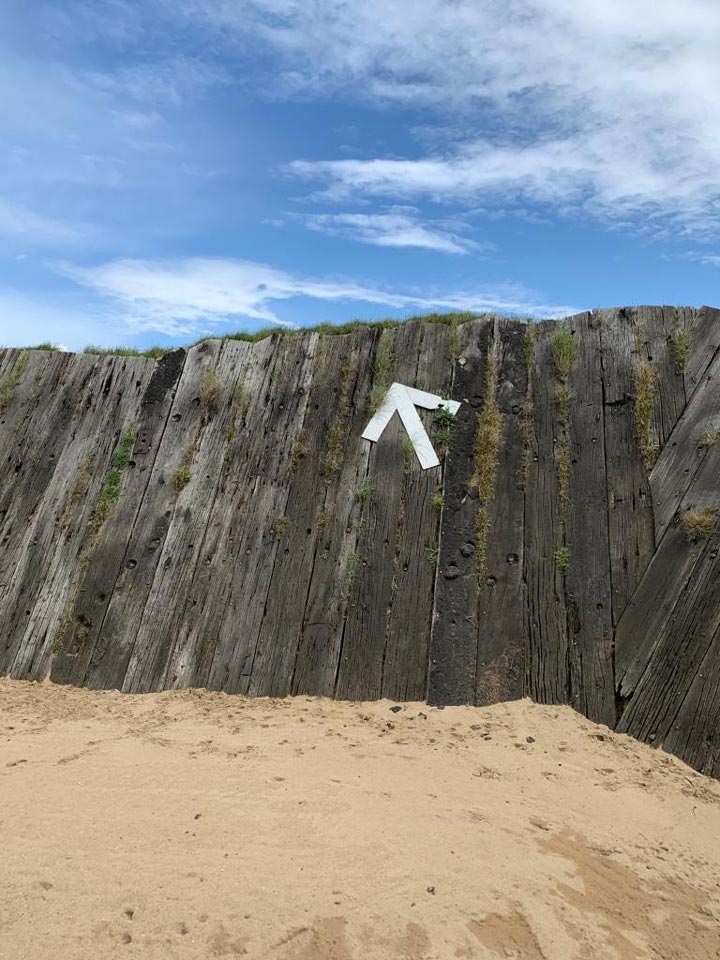
An unusual indication of the line of play at Royal North Devon
2. What do you hope the reader will glean from it?
I think I have posted about 800 blogs so far, and the answers to this question have come more from the feedback than from any specific intention. I know that it has helped many people to make the pilgrimages I made or their own versions, and the grateful feedback from those who’ve subsequently seen the majesty of Cleeve Hill or the subtle charms of New Zealand brings a tear to my eye. Just last week, a party of around twenty hickory players did a little tour of the Cotswolds, playing Cleeve, Painswick and Minch Old, and the resultant notes were a joy to read.
I also know of a few people who’ve thought “I could do that” in terms of writing, and whether it is good, bad or ugly (and I can never tell which of those my work is from day to day!), I encourage everyone to try and capture what such days – whether golfing, fishing, or playing the piano – mean to them. For me, it has embedded some chunks of memory that I can go back to, and the knowledge that I’d perhaps like to write about a place opens my eyes and ears and heart while I am there, always looking for themes, for clues…
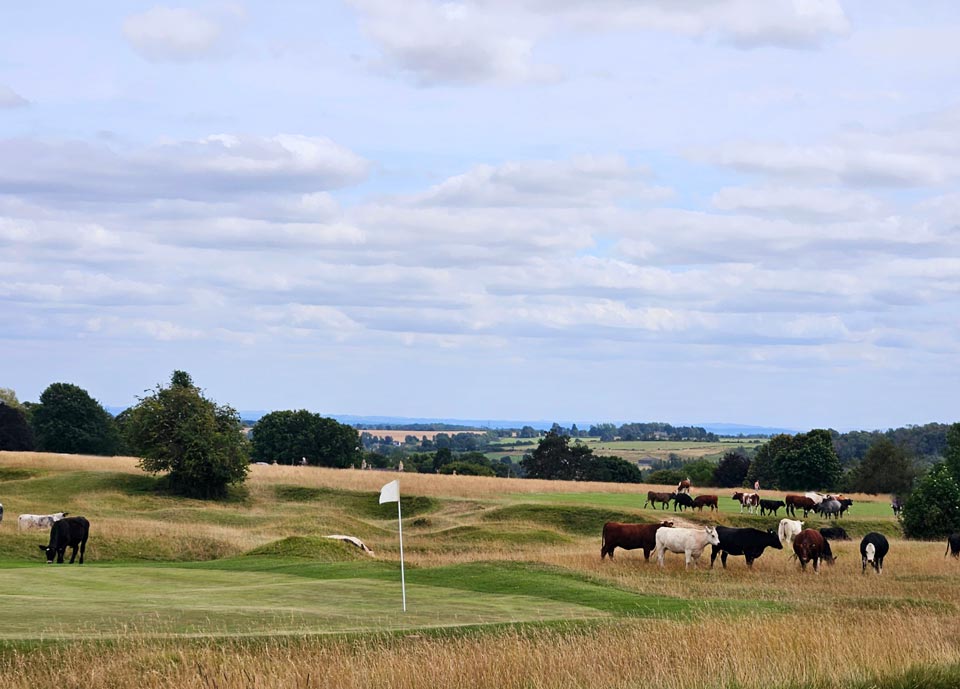
Minchinhampton Old on a busy day.
3. I love the sentiment at the start of the book – “These old courses are the strongest links I have to the present.” Please expound on that.
We could get very deep here! I think the simplest answer is that the simple joy of play is often lost as we grow older; our lives complicated by adult stuff and responsibility. But there is a place for unadulterated play beyond childhood, and for me that connection with the instant we’re in most often appears through golf. The flushed chip that somehow finds the hole; the crisp call of a curlew as we tread the ancient links. I’ve been interested in a life beyond the surface of things for as long as I’ve been interested in golf – a spiritual existence, if you like – and golf just happens to be one of the prisms through which some sense of the sublime or divine sometimes shines for me. I am biased, I know, but the sort of golf I want to play – fluid, instinctive, mindfully – is a trapdoor into a deeper way of being.
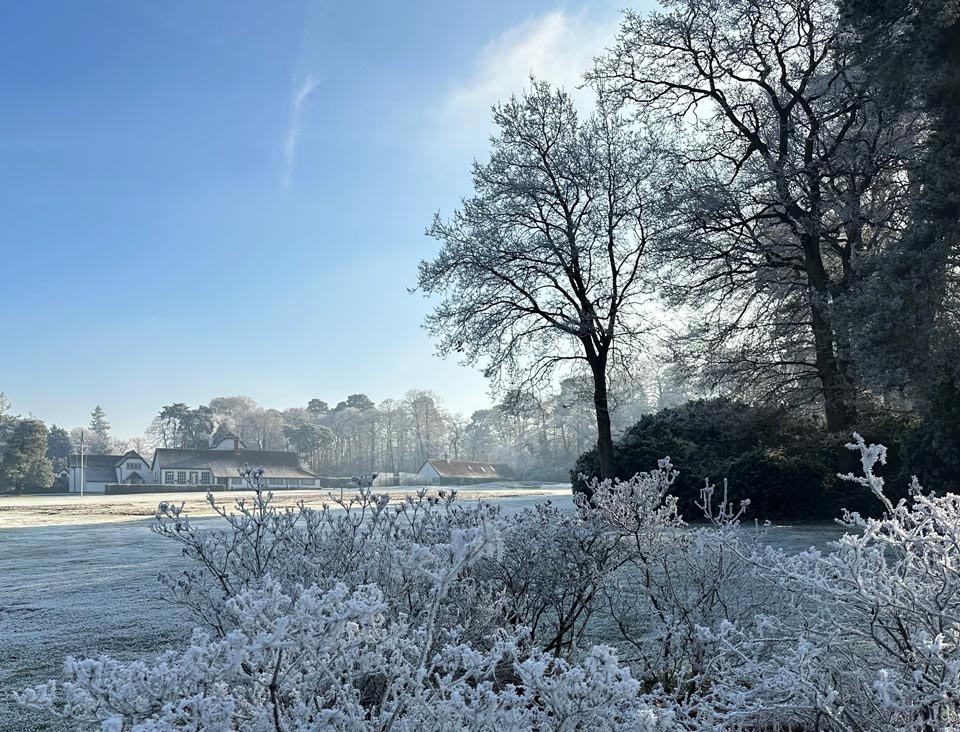
New Zealand, where even the winters are wonderful
4. Grass Routes started as a blog. What are the satisfactions of writing about a subject you love?
For me, it has been wonderful to discover that I can write well, on occasion. I love the process of trying to stay open for the clues, alive to the connections and themes that will emerge. It is such a thrill when a piece comes together, but often it is simply a reflection of the mindset that produces the occasional heavenly stroke…this stuff comes through us. But after doing it for a few years, I have found the most wonderful relationships form, often across social classes and oceans. And that is a satisfaction I’m unlikely to tire of.
5. You note not to miss out on the joy of playing round The Taylor’s course at Royal North Devon and the Northcliffe Course at North Foreland. Even to seasoned GCA readers, these courses are unknown. What exactly have we been missing out on?
This one is perhaps more specific to me, although I know others find the same joy in short courses. I grew up on Heath Park’s pitch & putt in Cardiff, and hit a million balls across that tiny little facility. So I’ve always had a soft spot for such places. Taylor’s was a timely reminder of that after the austere beauty of Westward Ho!, and then a few months later I somehow knew that my visit to North Foreland’s 18 hole par 3 course would be special. There’s a little gate that opens out onto this tiny plot of land, and you could ignore the whole thing in favour of a perfectly decent “proper” golf course next to it.
But it is valuable as a rare example of Fowler & Simpson working together, and if there is more fun to be had in golf, I’m yet to find it. It is golf for all ages and abilities, at £10 a round, and when I went back recently, and sneaked on with a member at first light, we had the pleasure of seeing a few dozen eager members flood through the gate and spread for the four corners of this little haven as the sun came up over France. It was, and is, magical.
6. Speaking of Royal North Devon, you cite the club’s brochure that states that it is “impossible to collect a full impression without playing there on several occasions.” So true! As we dash about trying to see “more of more,” do we inadvertently shortchange ourselves in the process?
I think there’s something in that. So many of the courses I know well have only revealed their depths after multiple plays – I think that is how we uncover the full extent of the architect’s genius. But at the same time, we only have a certain amount of time, and it is easy to keep on playing the same old loops with the same people. Part of the utter joy I found in writing the essays that would become “Grass Routes” was in the adventure of exploring new places. Westward Ho! was very important in that process, early on. I haven’t gone back yet, but think of it most days!
7. Who are the “Friends of Borth”?
It was a collective effort by a number of golfing societies to support a club in a difficult financial position. They had some financial and equipment issues and, given the fairly remote location, were struggling to get the modest revenue they required. A friend had mentioned it, as he was heavily involved, and I’d also seen something in Golf Quarterly about it, so had always been curious. It worries me sometimes that places like Borth and Cleeve Hill could get to a point where they are on the brink…thank goodness golf pulled together to keep these places going.

A peaceful evening at Borth and Ynyslas
8. Share with us several of your favourite restorations around greater London.
I must admit I struggle a bit with this. The fashions are for longer holes and uniform bunkers, and sand scrapes where none existed beforehand. Few clubs have the appetite or knowledge for a true restoration, and that’s fine – they can decide where they want to be in the marketplace. But there are two examples locally – both dear to my heart – that will be magnificent when done. Ryan Noades’ passion for the extraordinary thing that is Addington knows no bounds, and as the forestry work settles down and the turf delights in being reunited with the sun and wind, it is a glorious process to watch unfold. As I suspect Ryan does, I dream of the New Course being suddenly wiped of trees and council houses, for Darwin & co said it was the finer of the two – it must have been amazing. The Old is so courageous – brilliant, rollercoaster golf with a backdrop of the London skyline, so to think of how good the New must have been takes my breath away.
And St George’s Hill is in the early stages of what could well be a true restoration. They’re armed with an extraordinary team on that project, and have as full a picture of the heritage and original design as anyone could a century on. It’s a great place to play golf now, but if they do what I think they will, it will blow Colt’s other local masterpieces out of the water. The original courses were so bold, so courageous. So confident. Colt is one of the greats; we all know that. But from the little I’ve seen, this is the one where he had a free hand, where his strategy was best combined with an artistic flair and a trusting client. I know a few of the people involved, and simply can’t wait to see that develop.
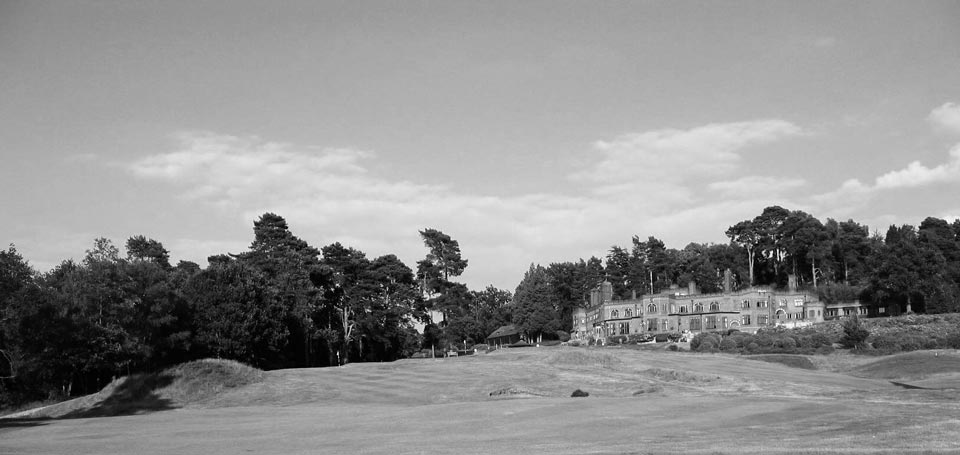
The 9th and 18th greens at St. Georges Hill, while the 19th awaits
Another interesting restoration near here will probably never happen but should. I wrote a piece for a future McKellar magazine on the short-lived solution Tom Simpson created, for getting from Woking’s 8th green up on to the plateau of Hook Heath. His holes were typically brilliant – challenging, teasing, controversial. The 10th would appear to be one of his own “mad masterpieces”, and the value to the club of embracing that heritage would be amazing. The current 9th is an abominable hole – a bitch to all but the elite player – and the 10th never quite feels right, mainly as the green was designed for a long-running shot across the angle of the hill. It was such a privilege to delve through the archive and find the correspondence between the likes of Darwin, Micklem, John Morrison and the Secretary of the time, “Monster”. Despite the name, he was well-liked but the holes he left behind are indeed monstrous.
9. You’ve a special love for the work of Tom Simpson. What are some favourite Simpson designs we should be on the lookout for? And what makes each so special?
I love his renovation work at New Zealand. It turned a Victorian, penal design into a subtle, strategic masterpiece, and the understated nature of the course a hundred years later remains utterly charming. It’s short, but you seem to hit an awful lot of very long second shots! The way he uncrossed the final two holes, creating in the process two masterpieces with which to conclude amazed me on the first visit, in 2006, and has amazed me every single time since. The 18th is just glorious, but in the mad dogleg of the 17th, and the wicked, pitched angle of the green and its wide open, camouflaged upper tier, there is genius.
Hayling is the nearest great links to where I live, and his influence there is equally wonderful. There’s something in his finish that preserves and enhances the grand beauty of natural landscapes, and a couple of the holes he “built” there would grace any links course. I think he built the 8th, where you lay up to a narrowing fairway then hold your breath for the blind second, and I read somewhere that John Morrison wrote something awful about it. But that goes with the territory of the artist, and when you consider that Morrison rubber-stamped Monster’s vandalism to Simpson’s 9th and 10th at Woking, it all sort of makes sense. But Simpson’s legacy lives on in the dunes at Hayling.
Unfortunately, a lot of what he did has either been lost or altered, and there’s a sadness around that for me. I do, however, intend to get to France just as soon as I am invited, where a lot of his masterpieces are intact and appropriately protected. Morfontaine, of course, and particularly the second course. Fontainebleau, just as soon as possible. Chantilly…the list goes on. But there’s something lovely in the fact that his legacy is so sparse. He was one of a kind, and like Abercromby, I like that it is relatively easy to go and see the pieces that remain. For Colt or Ross, that would be a lifetime’s work!
10. Tell us how an old sepia photo of yourself chipping as a 12-year-old served as inspiration for getting back to what you used to love in the game and the journey that involved.
I love this question…those times, moving from childhood into adolescence, were so vivid in my mind, so full of enthusiasm and energy and meaning. And hope! That image fell out of an old box of stuff – my parents’ lives stuffed into a plastic box – and it just transported me back to the sun on the patio of the Gwbert Hotel and all three of us lost in our own happy present. I feel like most of my time was spent with a wedge and a ball, and that holiday was sort of a sweet spot of its own.
There was also – not on the same trip, but in that span of a couple of years – another holiday where we went down to a sandy beach and I found a dune rising from the shore into which I hit endless pitches, every one rolling back to my feet. And somehow, though I love and appreciate the experience of playing a Pine Valley or a Muirfield as much as the next person, I am drawn more and more towards the simpler, shorter, more sustainable joy of knocking the ball around without any care for outcome.
Just to be connected with the grip and the ball and the present moment is something that feels to me like a valuable gift, and I am so grateful for the way the game – and writing about it – keep bringing me back here, time after time.
11. Tell us about that fateful day of foursomes at Deal and what it led to. As an aside, the photographs from Jason Livy that highlight Deal’s rumpled landscape are outstanding, so congrats on that.
I’d grown so tired of the rigours of running a club, and had come to what felt like a crossroads in my head. Woking had been great fun, mostly, but the degree of administration that goes into the job these days showed no signs of abating, and there was a feeling in my heart that I needed to find a change. And then – standing in the sun laughing with three good friends – I suddenly caught myself, and realised how rarely I did this – just played golf for the fun of it, or felt free enough to just stand still and feel the sun on my back.
I was slowly drowning in deep admin, and the fact that the admin was golf-related was irrelevant, for I was chained to the desk and no longer able to play or enjoy the game. Foursomes is – to me – the cure for many things, and I love Deal dearly, so it was sweet that this latest little epiphany took place there. However hard the stretch from the twelfth tee home is, however strong that prevailing sou’wester…it couldn’t be harder than getting up and going into work once the love had gone.
12. One round to go – where do you go and why?
It’s so hard to pick only one place, and so much of what I get from golf is bound up with the people I choose to play with, but I shall try. Great architecture does magnify the game for me, and sometimes – like at St Patrick’s Links recently or Sand Hills twenty years ago – the scale of an artistic achievement leaves me speechless, as great creative work ought to. The art of Rothko and Beethoven exist somewhere beyond language, and occasionally golf courses belong in that realm, though the non-golfer would find that suggestion ludicrous.
But I am also increasingly drawn to the rustic side of the game, and a more sustainable way of golf existing in the wider environment, and so to answer this question I have to look beyond my deep love of New Zealand, my instant passion for Durness and Brora and – of course – Cleeve Hill, and my deep respect for The Old Course and many of the other world-famous places.
There is a place that blends my own, personal taste for the perfect golfing ambience with the firmest surfaces, a sense of humour and the art of story-telling. A place I could write about every single day, and play every single day, and never, ever tire of or run out of fuel for the page or for my soul. To me, Rye is everything I’ve ever wanted or needed from golf and not a single blade of grass more.
It is perfect for me, in the way that “Pastoral Symphony” or “The Snow Leopard” or “Galatea of the Spheres” are perfect for me. And as far as I can work out, everyone who plays there – everyone who “gets” Rye – is singing from the same windswept hymn sheet, so perhaps instead of choosing three foursomes companions from the dozens of golfers I am blessed to call friends, I would just roll-up with some old clubs and see who is around for a game. And if no-one is free, I could just as blissfully go round and round by myself. I feel so lucky to live in a world where Rye exists.
13. As you travel around, some courses are bound to disappoint. Do you see common threads that run through them?
I try not to be negative in my writing, as there is space for all types of golfers and courses in this world. And the architecture crowd can get fairly strong in their opinions, and I don’t think it really does anyone much good. There’s plenty that I don’t like, but one thing sometimes seems to diminish a course is when the presentation gets caught up in the latest fashions. Too much furniture because someone is moaning about ball-cleaners, or the same fancy flags because the place down the road has them. There are many ways in which clubs seem to drift towards the average. But I love the places where the course persists despite it breaking a few of the so-called “rules” – of par values and balance and fairness.
There’s a whole world built on uniformity, but the great architects build holes in spite of the rules when the land requires it of them. They break the rules with intention when called to do so, and we are left with works of art to ponder and play. And I would love those places to embrace that which makes them different. The fourth hole at Woking, with those central bunkers of Low & Paton, is the obvious example, and I love that The Old Course was the primary influence on that development.
14. You suggest Painswick as a model of how to go ‘back to the future’. Please elaborate.
I don’t know all that much about Painswick, but I think what I was getting at was that golf doesn’t have to be all fancy and stripey to be magnificent, and fun. In fact, all that extra “stuff” – furniture, signage, fertiliser…it hides the real game, the game that spread like wildfire a century ago. I go out to breathe the air, be in the green spaces, walk with friends amidst wildlife, and test myself against the maddest game of all.
Painswick is another example of the soul of the game undiminished by the modern world. I love it, though I’m still grumpy that the perfect shot I hit last time on the fifth not only wasn’t in the hole, but was nowhere to be seen. Now that’s how a course can make you want to return!
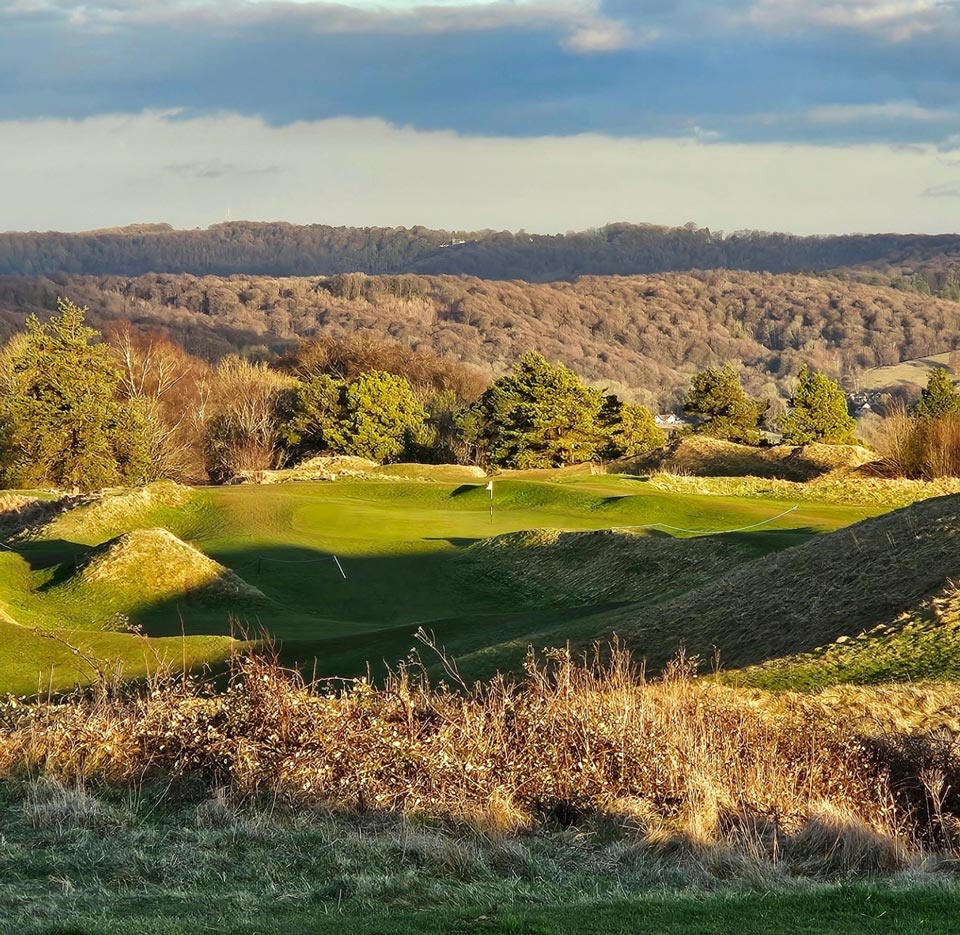
Painswick’s mighty 6th on a January day.
15. As 2022 progressed, you visited some less famous clubs. Why do you believe there’s a “deeper connection available” on golf courses at the rustic end of the scale?
Again, when we strip away the non-essentials – be that range-finders or fancy tee-markers or lavish clubhouses – we find that the fundamentals of the game remain as they were, and where the great architects have made their mark, there’s an eternal appeal and challenge. On a personal level, this space – this move towards simpler and simpler golf – creates for me the silence to hear and understand myself, so it is way more than a game for me. Golf is my teacher and the golf courses my therapy couch. It takes me away from both the past and future and into the now.
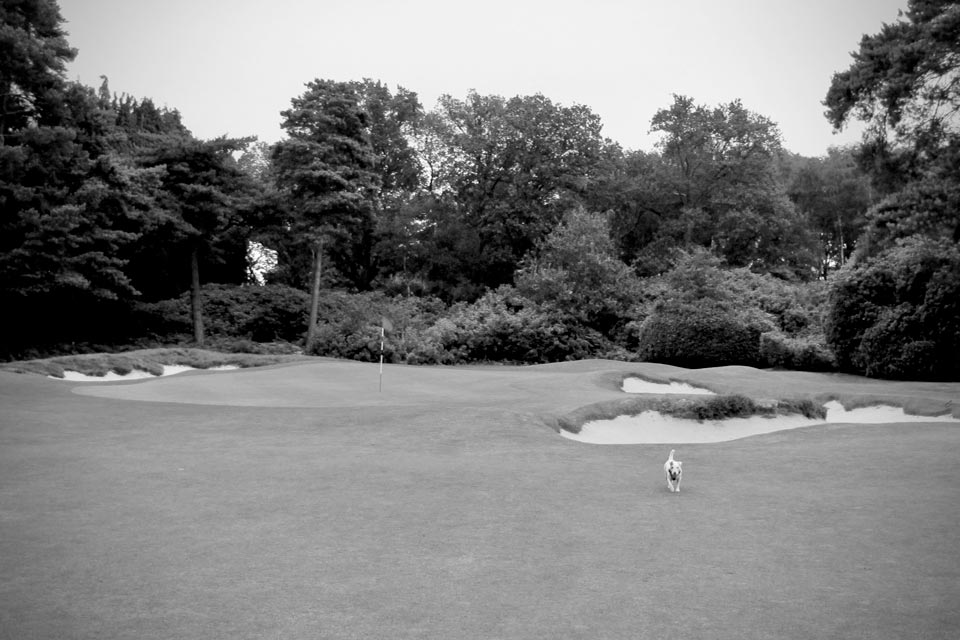
Simpson’s genial 17th green complex at New Zealand, from the late 1920’s, with the obligatory dog.
16. Foursomes is one of your true loves. Speak as to its virtues.
Golf is such an individual game, and while that is a valuable part of its challenge, I love the teamwork element of foursomes. Of course, we put each other in all manner of hell during a round of alternate shots, but it builds trust and empathy, and most of all a sense of humour that some golfers desperately need. I played recently as a stand-in Senior for a day, at Woking, and after trying to apologise on the second green, my partner quite rightly said “if we start apologising for our efforts now, we’ll do nothing else for the next three hours”, and I love that.
Someone kindly pointed out another factor in the social nature of foursomes, too – in the lull between alternate shots, we have these pockets of gentle strolling in which to talk more, the gaps between our turn often much longer. So foursomes is friendly, fun, and most of all fast. I’d play two rounds of fast foursomes over one round of fourball every single day given the chance. I love it, so much!
17. You enjoy reading as much as writing. Which golf writers do you return to?
So many to choose from…I flit between them. Darwin has had a profound influence on my escape from his beloved Woking and into the realm of the written word, and I am always staggered by the breadth of his subject matter, and the effortless flow of his skill. I’m not sure he left us very much to write about, really. Longhurst, Price. Alistair Cooke is a particular favourite. Robin Down’s books are wonderful, and celebrate a different type of golf. Lorne Rubenstein, Andrew Greig. And there’s a handful of people who dabble only in small chunks whose style I love. Aubyn Stewart-Wilson (New Zealand GC), Dan Miller (Goswick GC), my golf-obsessed friend Michael Estorick – they all wrote guest pieces for pitchmarks, and each one was exquisite…I wish they’d write more. David Normoyle’s writing is enchanting, bordering on the spiritual. So there’s a few, but I ought to read more. But I’m too busy writing!
18. Leave us with some parting thoughts…
I remember waking up from a dream during a summer holiday camp in the summer of 2021. It was shortly before the foursomes game at Deal that makes up the book’s first chapter, and I had been away from work and technology for a week at that point…just slowing down, reflecting. The previous 18 months had been full of challenges work-wise and in our personal lives – the pandemic had thrown everything up in the air – and the fresh air was working wonders, even without golf clubs.
And this one morning I woke up, and realised that in the dream, I’d seen my old boss – the Head Greenkeeper at Mitcham – and suddenly come to see that he was – is – the happiest person I knew. Doing a job he believed in, for all the right reasons. Caring for something on a level that few of us know. And it was a pointer that I needed to start again, go back to basics, try to write, and see what might happen. And that notion – of needing to be out on the course again, doing what I wanted to do instead of what I felt I had to do – just wouldn’t go away. So that dream was the primer for the change, in a way.
I feel so very lucky to have found in writing a joy that had been dormant, and for a rediscovery of the simplest forms of golf to be the portal into this writing life is an added bonus, for I love both hobbies. Or passions, perhaps…addictions. But there’s this other string pulling at me, too. About getting back into working outside one day, about tending my own patch of land, putting into practice all the skills I’ve picked up along this zigzag path. I rarely remember my dreams, but these days when I do, they are no longer hectic or anxious. They are calm, and blissful, and I feel like they are teaching my sleeping mind to listen to my heart.
Somewhere, in this life perhaps, or the next, there’s a place for someone who looks a lot like me down by the coast. And next to the ramshackle old cottage that appears most nights is a rolling field of waving grasses. And here and there a flag, and now and then someone comes to visit, and we golf together, and cut the grass a little – not too much – and we remember what the game was once like north of the border – all hairy and wild and natural. And some nights the course is a tiny miracle; all the best little pieces of a global puzzle coming together in the subtlest test. A few holes, but each a thing of wonder. And some nights the golf is so basic as to be comical, just torn flags in the breeze.
But the people who come go away happy, and have maybe learned something about themselves and their dreams, and how the universe is listening. Or they’ve managed to listen to themselves as we just walk and talk and laugh, and their lives will never be the same again, and for the better, for they’ve come to understand how free they are to choose, and to express themselves, and to laugh and cry. And one day maybe the ears of the universe will once again turn my way, and something magical will happen again, and when it does, you’re all so welcome. You’ll find me in the long grass, with a scythe or a mashie in my hand, and a smile from ear to ear.
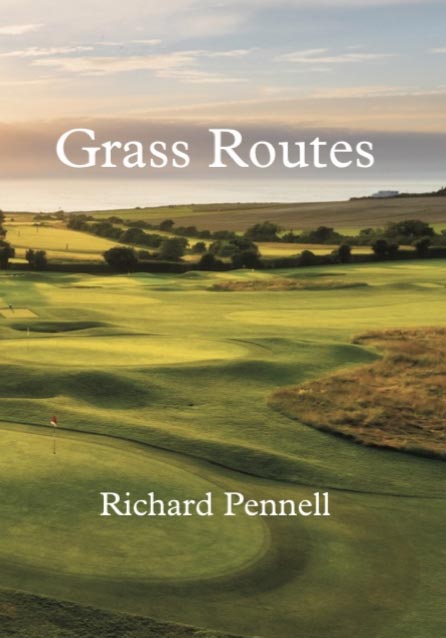
“Grass Routes” is published by Grant Books Ltd, and copies are available direct from the author via https://pitchmarks.bigcartel.com/product/grass-routes-by-richard-pennell.
Richard’s Sunday morning blog, “pitchmarks”, can be found here: https://pitchmarks.bigcartel.com/product/grass-routes-by-richard-pennell.
His earlier GCA interview can be found here: https://golfclubatlas.com/feature-interview/feature-interview-with-richard-pennell/.
Richard can be reached at pennellwriter@gmail.com.
The End








